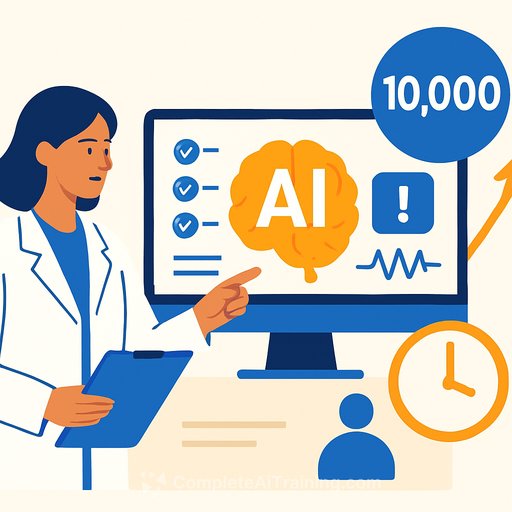Healthcare's Embrace of AI: What's Working Now - And Where To Be Careful
Adoption started slow. Now, nearly every corner of U.S. healthcare is testing or deploying AI. Leaders agree on one thing: AI should augment clinicians, not replace them.
The real work is in choices - what to deploy, how to train it, and where to draw the line. As one clinical leader put it, we can feed models biased data or prune sources to favor accurate, reliable knowledge. The outcomes reflect those decisions.
The shift: from "AI/ML" to usable, daily tools
Predictive analytics and machine learning have powered healthcare operations for years. Generative AI changed the interface, not the idea - like the web browser did for the internet. Suddenly, front-line teams can use language models to summarize, draft, and search with fewer clicks.
Unlike the 2009 push for EHRs under the HITECH Act, interest in genAI is coming from clinicians. They want relief from admin drag, faster documentation, and tools that fit clinical workflow. That demand is driving pilots, not mandates. HHS overview of HITECH
Ambient listening: fewer clicks, better presence - but watch the errors
Ambient tools now capture visits and generate notes in near real time. The time savings vary, but one consistent benefit shows up: clinicians keep their eyes on the patient, not the screen.
Accuracy still needs oversight. Reports include notes misgendering a patient or attributing a family member's condition to the patient. Once a bad fact enters the chart, removing it is hard. Human review stays mandatory.
From notes to personalized patient education
The next leap is turning visit transcripts into personalized education. Teams are testing systems that merge curated, organization-approved content with encounter context and the chart to create take-home plans.
That allows specific, everyday guidance. Example: if a patient mentions walking their goldendoodle or playing bingo, the plan can suggest concrete steps tied to those habits - not generic "exercise more" language.
Coding: accurate vs. complete
AI is improving coding accuracy. The gap is completeness. If a codable event is missing, revenue and compliance take the hit.
AI-first pass, human-final pass is the safe pattern. Let software surface candidates; let people decide what's missing and what stands.
Prior authorization: faster approvals, hotter debates on denials
On approvals, AI can read payer rules, auto-assemble documentation, and move routine cases faster - on both provider and payer sides. That frees humans to handle complex cases and exceptions.
Denials are another story. Many physicians worry AI is being used to increase refusals. Legal challenges are underway. Expect scrutiny to grow, standards to tighten, and transparency to become a requirement.
Clinical use: imaging, prediction, and operations
More organizations are moving beyond back office. In imaging, AI can spot patterns humans miss. Predictive models for readmissions - like return-to-hospital risk for patients headed to skilled nursing - are gaining traction when built and validated on the right data.
Operational wins are underrated. AI helps schedule rooms, instruments, and machines for higher utilization. Software doesn't forget, doesn't get stressed, and doesn't take bad days out on the schedule.
Liability, data volume, and what to keep
More data means more risk. If the AI flags something and it's missed - or fails to flag something - who is responsible? Policies vary, and case law is still thin.
One practical debate: keep the raw transcript, or only the vetted encounter note? Many teams prefer the final note as the record of truth. Others keep transcripts for audits and model evaluation. Decide up front and document it.
Build vs. buy: choose partners who know healthcare
The market is crowded. Some vendors bring proven models and healthcare depth. Others bring generic tech with weak clinical grounding.
One hospital installed a sepsis model that performed at 50% accuracy because it over-weighted elevated heart rate - a common reading in the ED. Ask vendors for clear validation methods, clinical input, and failure analysis before you sign.
Governance: standards, bias, and clinical pull
Bias and safety are design problems, not slogans. Curate sources, prune low-quality data, and test for bias across subgroups. Follow emerging standards and codes of conduct. The National Academy of Medicine has published guidance that many systems reference. National Academy of Medicine AI Code of Conduct
Most of all, let clinicians set the use cases. Small, high-value wins beat big platform bets that try to do everything on day one.
Action checklist for healthcare leaders
- Start where AI reduces administrative load without clinical risk: documentation, inbox triage, coding suggestions, prior auth prep.
- Keep a human in the loop. Require clinician sign-off on notes, orders, and any patient-facing materials.
- Pilot with a tight scope, clear metrics, and a 60-90 day window. Measure time saved, error rates, throughput, staff satisfaction, and financial impact.
- Use curated, organization-approved content for patient education. Combine with transcript context and structured data.
- Stand up QA and red-teaming. Test for hallucinations, misattribution, demographic bias, and unsafe suggestions.
- Set documentation policy: transcript retention, what counts as the legal record, and who is accountable for edits.
- Create an AI governance group (clinical, legal, compliance, IT, quality). Define approval gates, monitoring, and decommission rules.
- Demand transparency from vendors: training data provenance, validation cohorts, known failure modes, and monitoring plans.
- Avoid "black box" tools in high-risk pathways unless you have strong, local validation and clear escalation paths.
- Upskill your teams. Train clinicians and staff on prompts, oversight, and policy. For structured learning by job role, see Complete AI Training.
The bottom line
AI is useful where it removes friction and extends clinical focus. It fails where we skip validation, ignore bias, or treat it like a replacement for judgment.
Choose narrow, high-value use cases. Let clinicians lead. Build guardrails first, scale second.
Your membership also unlocks:






